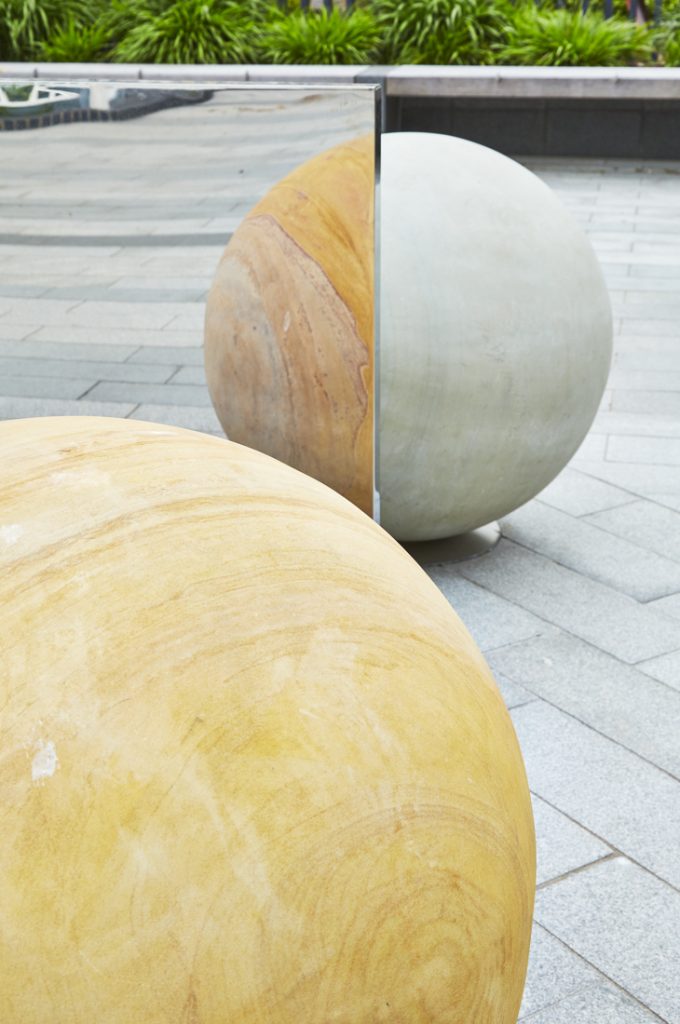Futurecity has worked in partnership with Mount Anvil to curate and deliver a series of public art commissions across three of their new developments in London: Untitled by fine jewellery designer Jo Hayes Ward at Queen’s Wharf (Riverside Studios), Column by artist-architect collective Studio Swine at the Lexicon, City Road, and Ecliptical Spheres by contemporary artist James Hopkins at Dollar Bay.
Ecliptical Spheres is one of three public artworks by Hopkins curated by Futurecity; the others are Playful Seating for Midsummer Lawn and Angled Ball. Read the interview with James Hopkins below.
FC: Can you tell us what it was like working at a different scale and in a new location / context for this commission?
JH: I tend to work to a scale, which is in keeping to the location and context of the site. The majority of my practice is concerned with creating site-specific sculptures, which engage the viewer with the role of judgment in connection to the process of vision. I am interested adapting objects and imagery in order to create sculptural interventions, which reflect and complement the context and site location for which they are created. This results in the production of high quality, long lasting and accessible artworks that are rooted in the local history and which the surrounding community can take pride in.
FC: How do the materials / fabrication methodologies that you used in this commission compare to your usual practice?
JH: I feel quite lucky in that there is a fairly natural transition between my studio based practice and public sculpture. Sculpture seems to function at its best when placed outdoors as it has a stronger sense of purpose and belonging. Scale and materiality obviously change in order for impact and longevity, yet an idea or concept behind the work can be equally effective if deployed at a large or small scale. When working for instance from 3D printing it is just as easy to print a small desktop sculpture from a STL file as it is to use the same format file to produce a CNC rolled steel grandiose sculpture. There is something immensely satisfying which derives from seeing an idea that transforms from a small model into the monumental.

FC: Has your practice / thinking developed as a result of the commission?
JH: My practice often circles around core elements (such as perceptual questioning) yet different commissions can allow you to approach the same sculptural concerns from alternative avenues. Ideas evolve through the process of commission based work that can often open up a new trajectory or facet to your approach to making sculpture. This can be subsequently mined in order to develop a new body of work, which I think is important for an artist’s oeuvre to appear continuously fresh and successful.
FC: Did the commission change your ideas of what you’d like to focus on in the future?
JH: This commission reinforced my interest in public art and the possibility of making sculptures that function in a public setting. Future focus is on building an archive of virtual work (some of which can be viewed on Vimeo), which might be able to function as a library of models that I can reference when creating public sculpture. This gives the opportunity of being able to work through ideas and designs without having to physically make anything, which avoids the big and problematic issues of the relationship between sculpture, storage and fabrication costs.
FC: How do you hope this commission will contribute to public art in the city?
JH: The city is obviously a very busy place and I have specifically designed a sculpture for a pedestrian corridor. The site is a transitory space and I have designed a sculpture to be viewed whilst walking past in order to kinaesthetically amuse the viewer and tease their perception. I am particularly interested in developing an artistic approach that utilises the passing pedestrians from around the site location, which also plays on the transitory movement of the audience. This results in an artwork that subtlety changes appearances depending on which direction the sculpture is approached and viewed from.
FC: What can we expect from you in the future?
JH: I’ve been thinking about making a map of permanent public sculptures in London. A series of art walks that joins the dots, between contemporary sculptures to create a sculpture trail. It would be a free downloadable and educational activity that encourages movement and exploration within the city.


